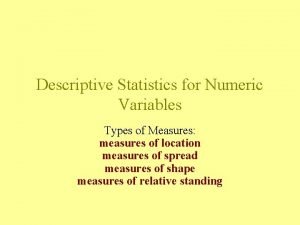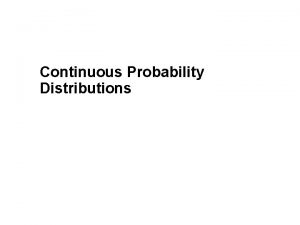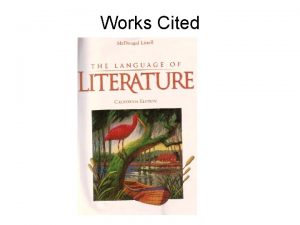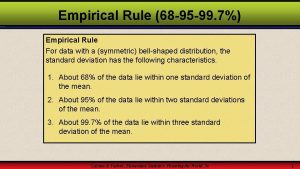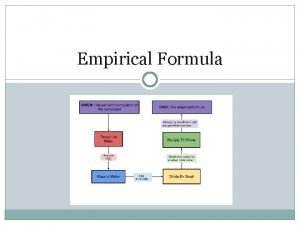Empirical Rule q q Empirical rule only works




- Slides: 4

Empirical Rule q q Empirical rule only works for a bell-shaped distribution. That is, empirical rule cannot be applied to other distributions such as leftskewed, right-skewed, and uniform distributions. For a bell-shaped distribution, the percentage or proportion of a data set that lie within an interval of the mean is determined under the following three rules q 68% of the observations lie within one standard deviation of the mean q 95% of the observations lie within two standard deviations of the mean q 99. 7% of the observations lie within three standard deviations of the mean. 1

Empirical Rule Example 12 a Suppose that on a certain section of I-95 with a posted speed limit of 65 mph, the speeds of all vehicles have a bell-shape distribution with a mean of 72 mph and a standard deviation of 3 mph. Using the empirical rule, find the percentage of vehicles with 63 to 81 mph on this section of I-95. Solution Given information: µ = 72 mph and σ = 3 mph 1. Convert the distance between the each of the points and the mean in terms of standard deviation. x- µ =63 – 72 = -9 = -3σ x- µ =81 – 72 = 9 = 3σ 2. According to the empirical rule, the area within three standard deviations of the mean is approximately 99. 7% for a bell-shaped curve. Therefore, 99. 7% of all vehicles on the section of I-95 with speed limit of 65 mph travel between 63 to 81 mph. x 63 =72 81 -3 +3 2

Empirical Rule p p p p Example: The prices of all college textbooks follow a bellshaped distribution with a mean of $105 and a standard deviation of $20. A) Find the percentage of all college textbooks with thier prices between $85 and $125 Solution: µ = $105 and σ = $20 Consider µ-σ to µ+σ $105 -20 to $105+20 $85 $125 So, approximately 68% of all college textbooks are priced between $85 and $125 3

Empirical Rule B) Find the percentage of all college textbooks with thier prices between $65 and $145 p Consider µ-2σ to µ+2σ p $105 -40 to $105+40 p $65 $145 p So, approximately 95% of all college textbooks are priced between $65 and $145 p C) Find the interval that contains the prices of 99. 7%. We know: µ-3σ to µ+3σ $105 -60 to $105+60 The interval that contains the prices of 99. 7% of college textbooks is $45 to $165 p 4
